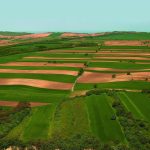Meet the charming capital of Slavonia: Welcome to Osijek! Where to stay, eat, drink, what to do and see. Getting around, festivals and more!
- Welcome to Osijek Croatia
- Top 5 things to do in Osijek
- Where to stay? Accommodation in Osijek
- Slavonia and Baranja food and drink: Croatia’s best?
- Museums, art galleries and theatres
- Football
- Day trips from Osijek
- Festivals and events in Osijek
- A few things most people don’t know about Osijek
- Weather in Osijek
- Osijek Map
- How to get to Osijek and get around
- Useful contacts
Welcome to Osijek Croatia
The Drava river separates two historic regions – Baranja and Slavonia. Today, although it is in Slavonia itself, Osijek is the capital city of Osijek-Baranja County, which includes all of Baranja. However, Osijek is also the cultural and social capital of Slavonia. Here Osijek sits, integral to lives across these vast areas, the fourth largest city in Croatia. And yet, although it is an economic and IT hub too, here you quite often don’t feel like you’re in a city at all.
Croatia’s greenest city
Osijek is Croatia’s greenest city, a city full of parks and riverside promenades. Being completely flat, it’s a gift for cyclists. But, if you can, the best way to take in Osijek is on foot. Because that gives you time to linger when you pass some of the incredibly detailed buildings here.

A city with 3 centres
The city actually has three centres, a result of it growing in an elongated manner, stretching down the river. Each holds its own draws and attractions. Around them, pretty tree-lined parks and streets and just beyond, rural villages. Indeed, although Osijek is itself very green, perhaps the best aspect of this place is its closeness to other amazing things, not least wild nature.
Kopacki Rit Nature Park, is just to the city’s north. Outside of its borders, the greenery is more structured. Agricultural land here produces some of the finest white wines in all Croatia. Unusually, they’re here paired with a full-flavored cuisine, the spiciest in Croatia. This menu is one of the most memorable parts of a visit to Osijek. As well as the people – some of Croatia’s warmest and most welcoming hosts. But, there’s much more besides, as we’ll see here…
Top 5 things to do in Osijek
1) Walk the Drava on the longest river promenade in Croatia

Walk leisurely the promenades on either side of the Drava river. Cross between them using Osijek’s famous pedestrian bridge. It’s spectacularly lit at night! Enjoy the view of the old part of Osijek Tvrđa from the other side of the river. On the city side, the promenade is now resurfaced – great for running and kids! Also on this side, you’ll pass by gorgeous parks and secession architecture.
2) Explore Tvrđa

Osijek’s Old Town, or Tvrđa (citadel), is the best-preserved and largest ensemble of Baroque buildings in Croatia. They are enclosed within a Habsburg star fort built on the River Drava. But, this is no relic. Some of Osijek’s best-loved cafes, bars, restaurants and nightclubs are here. So, it’s very much a living, breathing part of Osijek city life.
3) Enjoy the great outdoors in a city full of parks and monuments

Gosh, the air in Osijek is so much fresher than in any continental city. You’ll notice it instantly. Not least if you’re on foot. Because walking through Osijek, sooner rather than later, you’ll pass through a park or some pretty, tree-lined avenue.

In fact, from Ulica Kneza Trpimira, on the eastern side of Tvrđa, the best way to get to Osijek city centre is completely green. To put that into perspective – in case you’re unfortunate enough to have never been to Osijek – that’s 1.5 kilometres of park land and leaf-shaded, riverside route. Through the very heart of Croatia’s fourth largest city. Osijek’s parks are filled with intriguing statues. In fact, the whole city is littered with fascinating monuments.

Osijek statues and monuments

To catch the main ones, start at the beloved Red Fićo, a small red car overcoming a tank at the intersection of Trpimira and Vukovarska. Secondly, visit the the vivid ‘Dying Soldier’ by Robert Frangeš-Mihanović, plus the modern, mother and child and Miroslav Krleža statues in conjoined parks Držislav and Petar Krešimir.

You’ll find Pablo Picasso on the promenade, with two Sphinx near Cinema Urania. Furthermore, statues of Croatian violinist Franjo Krežma, president Franjo Tuđman and writer Augusto Cesarcu occur on the walk between Kapucinska and the huge Monument to Croatian War Veterans at the end of trg Slobode. Ante Starčević sits imposing over the square also named after him, with a modern seating sculpture just to his side.

4) Be stunned by the city’s Secession architecture

The city has a wealth of buildings built in the secessionist and art nouveau style. Informed by similar movements in Austria and Hungary, the ones here display distinct, regional flourishes.
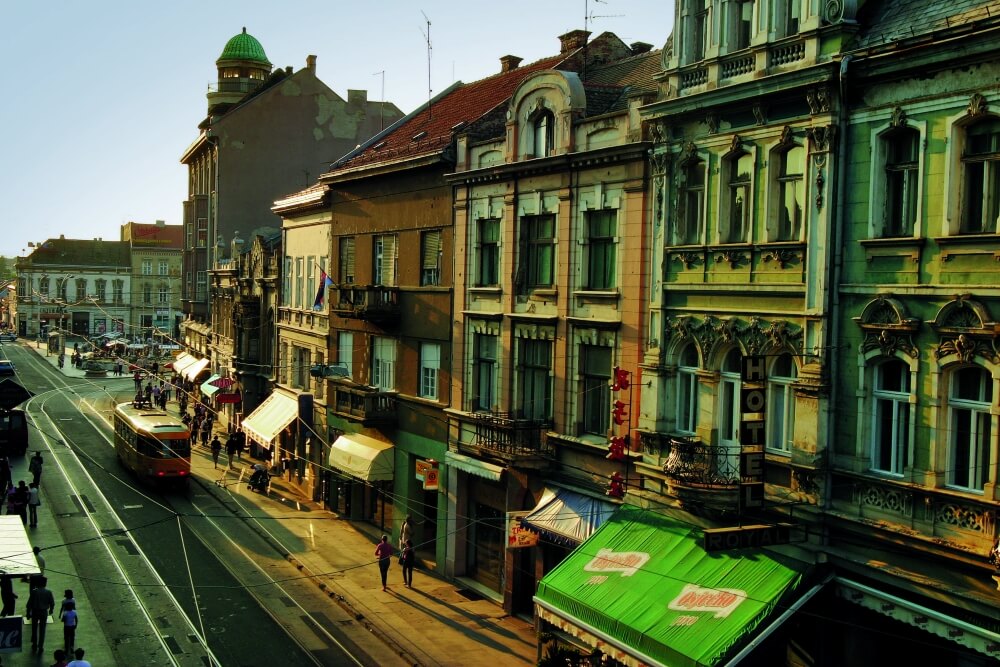
If you thought the Drava, Tvrđa and Osijek parks were beautiful, then just wait until you get an eye full of European Avenue. You’ll find more gems off the street, as you explore neighbourhoods around the city.

5) Discover the wider region in a day trip

Osijek is a brilliant base from which to explore the wider regions of Slavonia and Baranja. Not only do you have the vibrancy of a big city, but you’re surrounded by nature and fascinating rural endeavours. Furthermore, there are two national borders close by.
Hop across to Hungary or Serbia for sightseeing and gastronimic exploration, if you like. Although, there’s so much to explore in Osijek, Bilje, Baranja, Dakovo, Vukovar and Vinkovci, you’ll struggle to fit everything in. If day trips are an essential part of your holiday, then Osijek is one of the best places in Croatia to visit. For specific ideas about day trips from Osijek, see our dedicated section below.
Where to stay? Accommodation in Osijek

The city has something for every taste. Accordingly, you’ll find hotels, private accommodation, guest houses and hostels.
Many are within old, beautiful baroque and secession buildings. Subsequently, they combine modern interiors with historic exteriors. Also, many offer bike rentals too. One of the best of these is Maksimilian Guest House. Not only is it right in the heart of, but also it has a delightful garden in the courtyard with topiary.
Hotel Osijek is a 4-star stay, with great views directly overlooking the Drava. Additionally, Hotel Silver on the other side of town has nice rooms and pleasant staff.
Check out the best deals for accommodation in Osijek below:
(function(d, sc, u) {
var s = d.createElement(sc), p = d.getElementsByTagName(sc)[0];
s.type = ‘text/javascript’;
s.async = true;
s.src = u + ‘?v=’ + (+new Date());
p.parentNode.insertBefore(s,p);
})(document, ‘script’, ‘//aff.bstatic.com/static/affiliate_base/js/flexiproduct.js’);
Slavonia and Baranja food and drink: Croatia’s best?
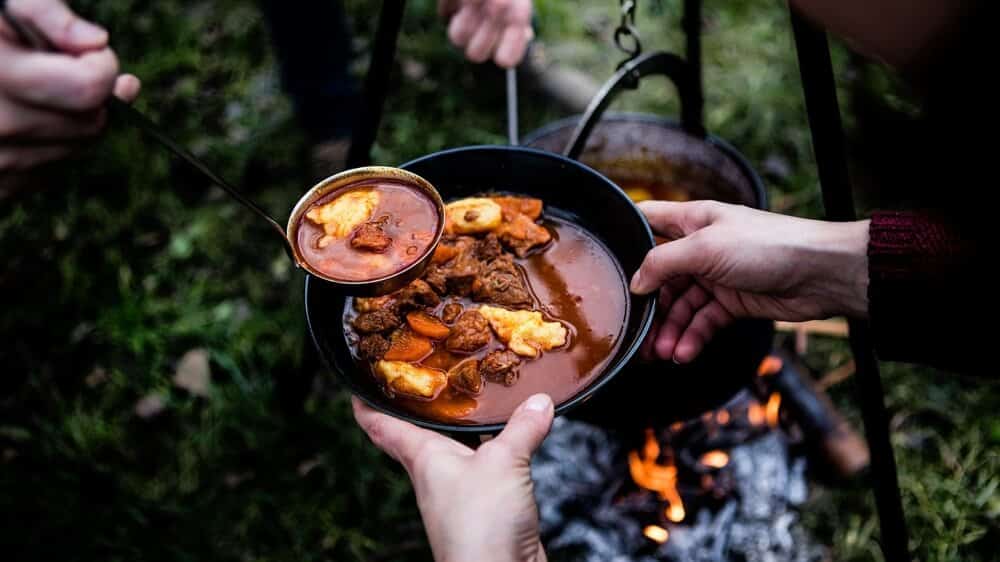
Depending on preference, Slavonia and Baranja have the richest traditional food in Croatia. Of course, seaside cuisine is great. But, it’s much the same around the whole Adriatic. And, like the rest of Croatian food, it’s relatively conservative in its flavour.
Paprika and river fish
Markedly, the meals in Slavonia and Baranja are different. You’ll taste fresh, strong paprika in local stews and soups. Čobanac made with wild boar and deer, and Fish paprikash are coloured deeply red by its use. Undoubtedly, the tradition has seeped across the border from Hungary. Fish paprikash is just one way you’ll see river fish cooked here. Another is carp, speared on sticks and slow-roasted over an open fire.

Both bakery, like kiflice and pita, and sausages like kulen and kobasice, are fantastic here. Don’t tell anyone else, but the best slanina (bacon) in Croatia comes from here. And Croatia’s best white wine is from this region. Indeed, there’s a whole world of flavours to discover on both sides of the Baranja-Slavonia border in Osijek.
Craft and local beer
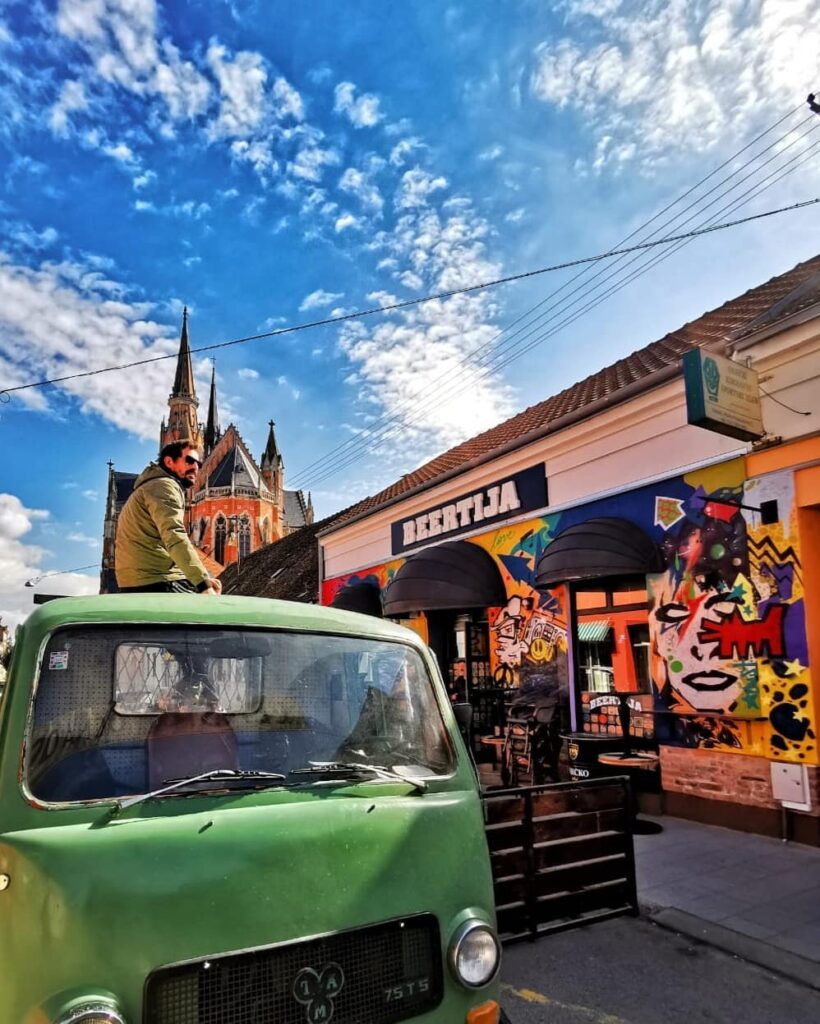
Osijek has the oldest beer brewing in Croatia, ever since the 17th century. It’s made by the town’s Osječko. Without question, their black beer radler is the best of its kind in Croatia. Now filtering out into many of Osijek’s brilliant bars, the craft beer scene is very healthy here. Bars like Gajba, General von Beckers, Runda and Beertija are great places you can try some.

Sample Slavonia and Baranja wine

In truth, Osijek’s wine offer has been hit hard in recent times by the sad closure of both Muzej Okusa and Vinska Musica. But, at the city’s great wine store Vinoteka Vinita you can both buy and try excellent wines. Of course, they place a strong emphasis on the wines of Slavonia and Baranja. But, you’ll find they have more besides.
Restaurants in Osijek

Slavonska pizza
No, we’re not kidding. There’s a specialty pizza from Slavonia. What’s more, it’s maybe the best pizza in Croatia, when made correctly. Slavonska pizza is a festival of pig, with no less than 3 types of pork meat, onions, cheese, tomato sauce and chilli peppers. If that isn’t gut-busting enough, ‘then go the ‘whole hog’ and ask for an egg on top. Incredible! You probably won’t find this pizza anywhere else in Croatia. If you do, then it won’t be as good as it is here. For pizza in Osijek, try Rustika, SportHouse, Corolla and Saloon. In particular, Rustika is a lovely place to go for a meal.

Regional cooking at its best
The offer of traditional food in the city centre is not as great as it once was. Not least since the sad closure of Kod Ruže. However, you can still get great traditional food in the centre thanks to the ever-dependable Slavonska Kuća. But, if you want to try traditional food in a different setting, head out of town.

Markedly, there are a wealth of excellent eateries nestled in the surrounding countryside. Vrata Baranje, Čarda kod Baranjca or Crna Svinja are good examples. In truth, there are just too many to mention. Moreover, they usually have a great, informal ambiance and views. If the view is a must and you don’t want to go far, then try Čingi Lingi čarda. It’s the new kid on the block, just north of Osijek in Bilje. Generally, the food is a contemporary take on Slavonia-Baranja favourites, exquisitely presented by the riverside.
In the city
If you prefer to grab something in the city itself, then there are two more notable options. Lipov Hlad in downtown Osijek has a great selection of pizza, burgers, sandwiches, wraps and more. If you want something more formal and fancy, then try Lumiere, who also have great wine. In Tvrda, Merlon is a great bar to grab a burger and fries.

Museums, art galleries and theatres

Museum of Slavonia and Archaeological museum Osijek are places to go if you want to learn more about the history of these parts. Both these museums are on Trg Sv. Trojstva, the central square in old town Tvrđa. Museum of Slavonia is very active in organizing really interesting themed workshops, programmes and exhibitions.
Museum of Fine Arts is placed in an 18th-century neo-renaissance building. It has more than 5000 paintings, drawings, graphics and sculpture collections from 18th to 20th century. On the building facade, you’ll see a section with a different appearance. It was damaged by a grenade during the last war.
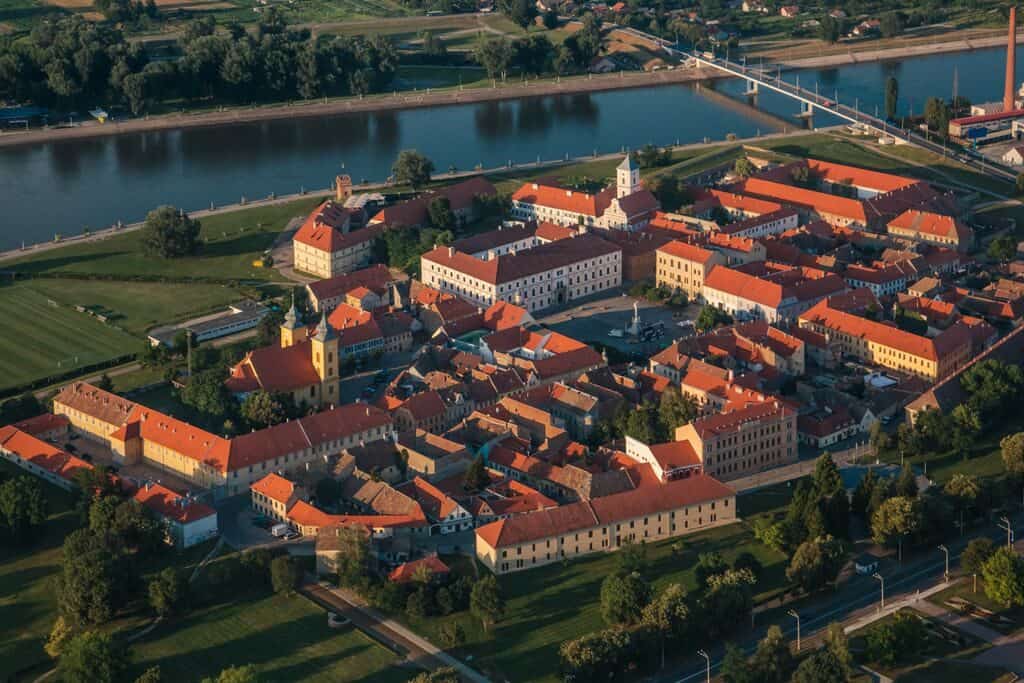
Theatres
Croatian National Theatre Osijek (Hrvatsko Narodno Kazaliste Osijek). Osijek has enjoyed a theatre tradition since 1735. Subsequently, the Croatian National Theatre Osijek was founded in 1907. Today’s building, near the main square, was built in 1866 and has elements of Moore architecture. Additionally, the theatre offers an annual repertoire of fifteen permanent titles and organizes other cultural events.
Children’s Theatre “Branko Mihaljevic.” A historic puppet and children’s theatre in Donji Grad (Lower Town). It is named after the author of famous Croatian children’s song “Zeko and Potocic” (The bunny rabbit and the creek).
Football

Considering football is something of a national sport, Croatia has the most boring domestic league football in Europe. One team dominates every cup and league title. Year after year. Mind numbingly boring. However, in recent years, Croatian league football has been offered hope. Largest team of the Kvarner capital, HNK Rijeka, have played in Europe. So too have NK Osijek who, in the 2020/2021 season have arguably Croatia’s best domestic coach, Nenad Bjelica.
Also, thanks to considerable investment, they have an amazing new stadium on the way. Could they save Croatian domestic football from the endless tedium by grabbing the title? Certainly, they are close. In fact, in the 2020/2021 season, NK Osijek was second place in the Croatian first league by quite some distance. Also, you should keep an eye out for them hopefully progressing in European competition.

Gradski vrt and Pampas
Osijek’s beloved old stadium is called Gradski vrt (City Garden). In fact, it is so named because, indeed, this place once housed beautiful city gardens. It lies in the neighbourhood Vatrogasno naselje, on the border with Sjenjak, in the Novi Grad section of the city. However, the new stadium will be located in the westerly Retfala neighbourhood. One Osijek fan, Antiša, told us that probably, once opened, the new stadium will carry a sponsor’s name. However, for now, NK Osijek fans refer to the new stadium as Pampas, because of the area in Retfala where it’s located. Maybe the name will stick?

Day trips from Osijek
Bilje and Baranja

North of the city, there’s a whole other region to discover in Baranja. Coupled with the beautiful wines you’ll find, the wild world of Nature Park Kopacki Rit will dazzle you. Its natural beauty and wildlife satisfy year-round. Food in traditional Baranja village restaurants is the real deal of regional cuisine. Or, you could visit an OPG (family farm), take a pottery workshop, a cookery class or more. Bilje is the very first village in Baranja as you cross the Drava in Osijek. Not only does it hold Kopacki Rit and several great restaurants, but also some super OPGs and a small castle. If you want to read more about Bilje, Baranja, its unique winemaking traditions, and some of the OPGs, then look here.
Vinkovci, Vukovar and Ilok

There are some exceptionally interesting towns a little further east of Osijek. Did you know, for example, that the oldest continuously inhabited town in Europe was near Osijek? Vinkovci dates back 8,400 years. Additionally, it was the birthplace of two Roman Emperors. Moreover, it has a magical folklore festival, Vinkovacke Jeseni.

For those of Croatian origin, Vukovar is a solemn place of war remembrance. But, there’s tons of great stuff to do there besides, including many activities. And the amazing street art left behind by its annual festival. If you want to learn more about the Vukovar offer, read our detailed guide. Nearby, Vucedol has a beer tradition dating back an incredible number of years.
Ilok
Keep going a little further and you’ll reach Ilok. It’s one of the most important wine towns in Croatia. Visiting its world-famous Ilocki Podrum is essential. Furthermore, this was the winery that supplied 11,000 bottles for the coronation of Queen Elizabeth II. If you want a tip, then try their Traminac.
Đakovo and Slavonski Brod

Going to the south, Đakovo is the first town to stop. See its beautiful, big cathedral. Afterwards, visit the State Stud Farm, which traces its roots back to 1506. If you want to read more details and see more pictures of Đakovo, then look here.
Additionally, the memorial gallery of famous Croatian sculptor Ivan Mestrovic is in Vrpolje. Actually, it’s on the way to Slavonski Brod. There, you can learn more about the most famous Croatian love story of all. Storks Malena and Klepetan come together each year. And you can see the lovebirds in the video below.
In Slavonski Brod, visit Tvrdjava, the largest fortress in Croatia. It was built in the 18th century. There you’ll find out more about great Croatian fairytale writer Ivana Brlic-Mazuranic.
The towns and villages of Slavonia
To the east of Osijek, the villages of Aljmaš and Erdut have a 10 kilometre riverside path by the epic Danube. In Erdut, climb the hill to look down on the mighty river as it sweeps through the whole vista. You can read more details about Erdut here. Further to the west there are more Slavonian beauties. Specifically, in Nasice, Donji Miholjac, Kutjevo and Virovitica you’ll find beautiful castles. And vineyards. There are more gorgeous wines to taste in the Pozega region. And more craft beer to drink in Nova Gradiska. In fact, Gradiska has the first craft beer tasting business registered in Croatia – Bosnjak Beer & Gin.

Alternatively, take in more stunning nature and go hiking in Nature Park Papuk.
Festivals and events in Osijek

Capital of culture for Slavonia and a large university town, something’s always going on in Osijek. Osijek antique fair takes place open-air in Tvrđa every first Saturday. Festivals such as the Craft Beer Festival, Evening of Wine&Art and WineOs Festival are wonderful al fresco occasions. Moreover, they have great musical accompaniment. Head On East Festival celebrates the food and culture of the entire region. ReArt is a multi-discipline arts festival, with a brilliant atmosphere, great music and an open-minded, youthful crowd. UFO Festival is the city’s big annual outdoor music festival. But, look out for the end-of-university term parties too. Especially if you enjoy music outdoors.

Pannonian Challenge is the largest extreme sports event in Croatia and the wider region. It’s held annually at the recreation centre Kopika on the other side of the Drava. Other important events include Advent, Easter and Osijek Summer Nights.
A few things most people don’t know about Osijek
Slama: Seasonal Land and Nature Art

The city has its own natural artist in residence. Nikola Faller of Slama Osijek creates seasonal artworks using ice, leaves, sand, straw and snow. If you want to check out the full range of his amazing creations, then look here.
The first tram and passenger train in Croatia
Osijek was the first city in Croatia and this part of Central Europe to have modern urban transport. A horse-drawn tram started to operate on 10th September 1884. At the time, Osijek had some 18,000 inhabitants. It ran along a 10 km route from west to east. The branch line that connects Osijek to Pecs in Hungary was the first passenger train line in Croatia.
Holy Trinity Square in Tvrđa is on the 200 kuna note.
British royal family connections
Franz Paul Karl Ludwig Alexander von Teck was the father of Queen Mary. And he was great-grandfather to Queen Elizabeth II. He was born on 28 August 1837, in Osijek. The Prince of Wales and Duchess of Cornwall visited Osijek on 15 March 2016.
Osijek ethnomusicologist and music historian Franjo Kuhac noted Germany’s national anthem had origins in Croatian folk music. Not convinced? Have a listen and decide for yourself.
Tunnels of Tvrđa
Two-hundred-year-old underground tunnels and canals lie below Tvrđa. Moreover, they are rumoured to extend beneath the Drava river too. They originate from the Austro-Hungarian times. But, could some of Osijek’s fabled underground be remnants of the Ottomans once here? Specifically, the ones we know about were used to transfer soldiers, weapons and food in times of danger.
Weather
The climate in Osijek is mild, and generally warm and temperate. However, Osijek does have significant rainfall during some parts of the year. Generally, the months of May and September are very warm and pleasant. On average, the temperature in these months is around 18 °C. Unsurprisingly, June, July and August are the warmest months, with an average of 23 °C. If you want to see the weather forecast for Osijek today and the next few days, then look below.
Where is Osijek? Osijek Map
Osijek is in northeastern Croatia, next to the Drava river. Actually, it’s not far from the confluence of the Drava and the Danube.
In detail, Osijek GPS coordinates with respect to latitude and longitude are 45.5550° N, 18.6955° E. The Osijek zip code is 31000 Osijek (postal code).
How to get to Osijek and get around

Osijek was the first city in Croatia to have a tram system. In fact, trams still run through the city – it’s the only place in Croatia outside Zagreb that has trams. Also, Osijek was one of Croatia’s first cities to receive an international rail route. That too survives, travelling between Pecs in Hungary and Osijek via Beli Manastir. Additionally, Osijek has one more unique form of transport. ‘Kompa’ is a cabled ferry that takes you from the city side of Osijek, across the Drava, to Osijek City Zoo. Interestingly, it uses only the power of the river flow to make its journey.
Road

In light of its closeness to the E70, Osijek is well connected to the European motorway network. Also, this is the road to take if travelling from Zagreb to Osijek. Turn off the E70 at Čvor Sredanci junctions, then take the E73 to Osijek. Driving time between Zagreb and Osijek is about 3 hours.
Running from Budapest to Ploče, via Osijek, the E73 is the quickest road route between eastern Slavonia and southern Dalmatia.
Looking for a fast, reliable and trouble-free transfer to or from Osijek? Contact TC transfer partner Adriatic Transfers for your one-stop solution.
Intercity bus to Osijek

An increasing number of bus connections run from the city to Western Europe. Hungary, Bosnia, Slovenia, Austria, Germany and Switzerland are among the countries which have direct bus services. Usually, you can travel to Osijek by bus from Belgrade and Novi Sad in Serbia. And direct from Croatia’s coastal regions Istria, Kvarner and Dalmatia. Moreover, there’s even a route from Montenegro, via Dubrovnik and Posušje.

Train to Osijek
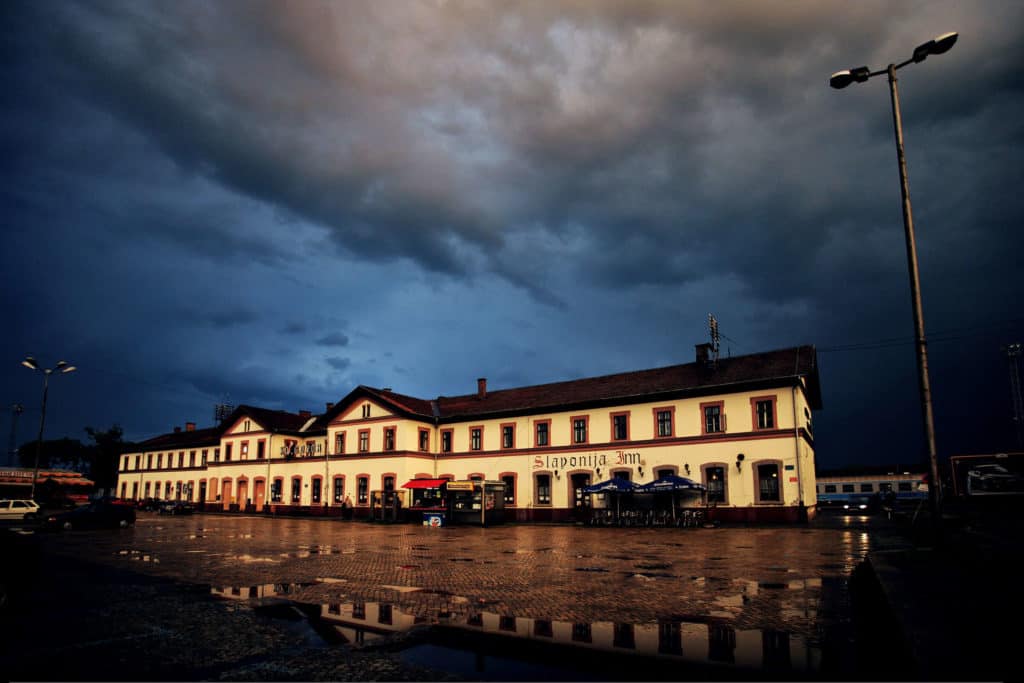
There are also numerous options by train. Osijek is connected to the main Croatian rail network. Several trains depart daily to Zagreb, the journey taking about 4.5 hours. Also, Osijek is 43km distance from Vinkovci and it takes around 55 minutes on the train. Previously, Vinkovci was Croatia’s third best-connected city by train, after Zagreb and Rijeka. Actually, it’s gradually regaining this title.
Previously, a popular Budapest-Osijek-Sarajevo route ran here. Sadly, that no longer functions. But, services have resumed to the southern Hungarian city of Pecs, via Beli Manastir. Check out the latest train timetables online on the official site.
Flights to Osijek

There were big hopes for tourism and greater international connectivity when Ryanair started flying to Osijek from London. Sadly, the route was short-lived. Osijek Airport now operates well under capacity. However, co-operation between several Slavonian tourist boards has catalysed efforts to return budget air carriers to Osijek. Subsequently, things were looking up for the region’s connectivity by plane. But, the pandemic of 2020 put a hold on much airline expansion. As of writing, flights remain in a state of tentative fluctuation. However, you can learn more from Osijek Airport’s website. And from reading the Total Croatia Osijek Airport guide.

Getting around the city
Osijek is a very pleasant city to walk around. Indeed, you can walk between all of the city’s key areas without barely leaving fantastic park ground. And we recommend you do just that. However, Osijek is also nicely covered by public transportation. In this case, that means cheap local buses and trams. Additionally, there are well-priced taxi services.
It costs only around 20 kuna to travel anywhere in the city (within 5 km). Independent taxi drivers and companies like Osjecki taxi or Cammeo are what you need. Beware the ‘set price’ from the city to the airport. It is WAY above the regular price per kilometre. Furthermore, it’s your only option unless a friend takes you. Unbelievably, no public transport link exists between the city and airport. Check out the bus and tram routes below.

Useful contacts
Osijek Tourist Board is a very friendly place. Check out the Osijek Tourist Board website for more information about the city.

If you want to learn more about the wider Osijek-Baranja County, look here.
Looking to learn more about Osijek? Here is Senka Vlahovic’s great TCN piece, 25 things to know. And once you’ve finished that, move on to the region. 25 things to know about eastern Croatia.
Both the city and county tourist boards can recommend guides for tours. But, one of the best to Osijek, Slavonia, Baranja and Đakovo is Kulen Travel here.
If you want to keep up with the latest from Osijek, then check the dedicated TCN news page.




